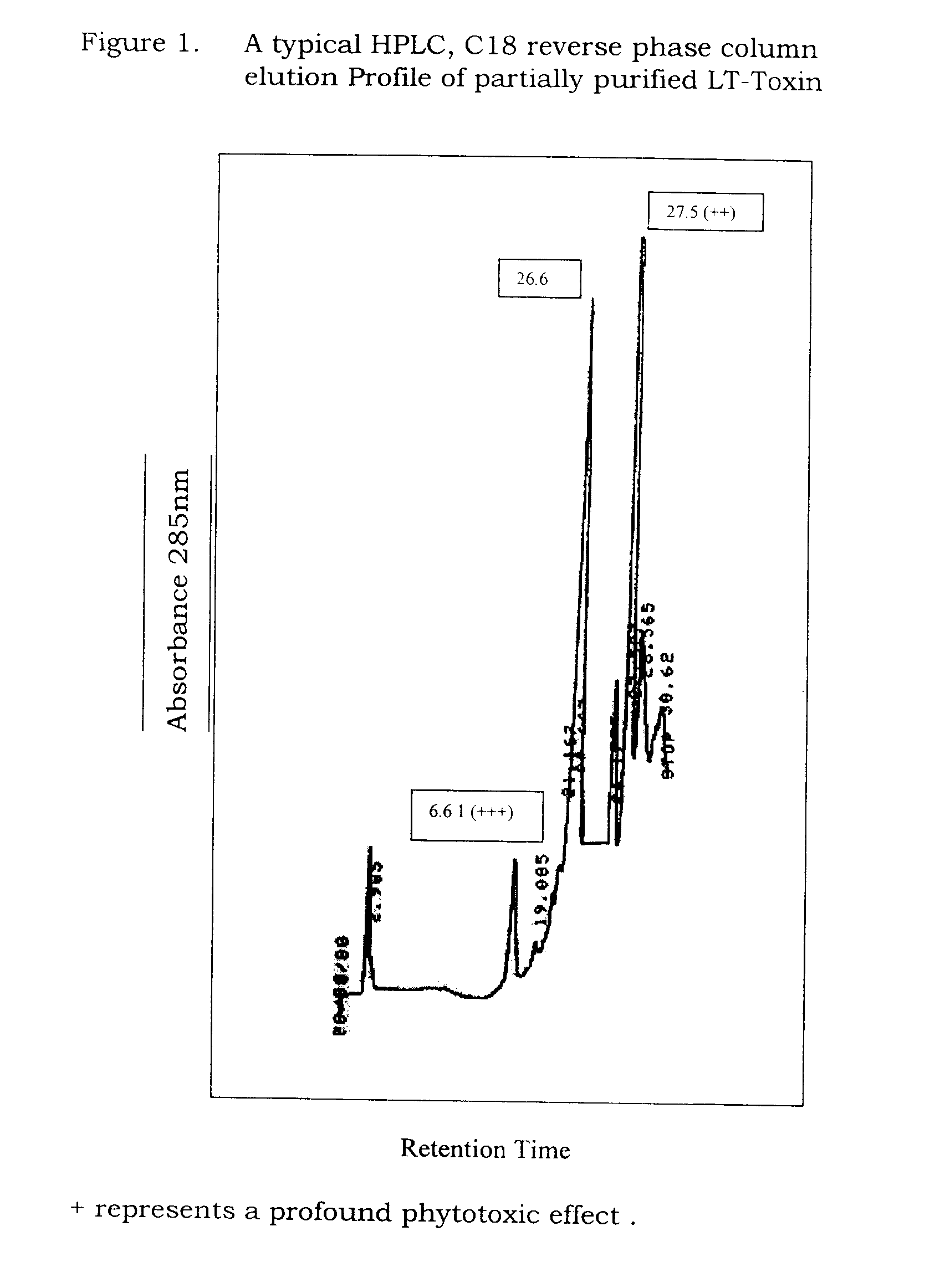Herbicide comprising phytotoxins of Lasiodiplodia theobromae (LT) fungus, a process of producing the herbicide and a method of using the same
a technology of lasiodiplodia theobromae and phytotoxins, which is applied in the field of herbicides comprising phytotoxins of lasiodiplodia theobromae (lt) fungus, can solve the problems of plant being susceptible to microorganism attack, severe loss to farmers, and phytotoxins not showing growth inhibition, etc., and achieves the effect of easy determination for each target weed species
- Summary
- Abstract
- Description
- Claims
- Application Information
AI Technical Summary
Benefits of technology
Problems solved by technology
Method used
Image
Examples
example 2
An observational trial was conducted to evaluate the bio-efficacy of culture filtrate of Lasidiplodia theobromae against herbs including weeds. The trial was laid out in non-crop area infested with the following weeds: Amaranthus viridus, Axonopus compressus, Cynodon dactylon, Dactyloctenium aegyptium, Digitaria sanguinalis, Euphorbia geniculata, Euphorbia hirta, Panicum repens, Parthenium hysterophorus, Sida cordifolia and Trianthema monogyna.
Twelve plots each of two meter square area were demarcated for the twelve treatments (Table 2). Successive plots were separated by a strip of weeds of 30 cm width which was untreated. All the plots were uniformly infested with weeds, which were under 10 cm in height. Treatments (Table 2) were imposed as post-emergence spray. Low pressure developing hand sprayer was used to spray twice weekly. Volume of spray fluid used was equivalent to 500 liters per hectare.
Qualitative assessments were made twice a week after imposing treatment. Marginal and...
example 3
Excised Parthenium leaves were used to test the, biological activities of crude and cell-and spore-free filtrates. Excised leaves were placed on moistened filter paper inside 9-cm diameter sterile petri plates. The inocula of crude filtrates, cell-and spore-free filtrates, and the phytotoxin standards were applied to the leaves with micropipets. Amounts used were 100 .mu.l to adaxial or abaxial surfaces at concentrations of: (a) 10 g / 100 ml distilled water for the crude and cell-free filtrates; (b) 25 mg of partially purified dissolved in 60 ml of 10% DMSO. Ten leaves were used for each treatment. Control leaves received either potato filtrate, distilled water, or 10% (v / v) DMSO. The plates were sealed with paraflim and incubated under continuous or 12 h light (20 uE.m.sup.-2 s.sup.-1). The phytotoxic effects on the treated excised leaves were evaluated visually for damage for 10 days. Crude and cell-free filtrates and LT-toxin caused similar damage to excised leaves, characterized ...
example 4
LT-toxin was applied to excised Parthenium leaves to determine a dose-response curve. Primary and secondary leaves from greenhouse-grown 20-day-old Parthenium plants were used in this study. The LT-toxin used in this study was produced and purified in the following manner.
Growth of Cultures
Lasiodiplodia theobromae was grown at 24. degree.C. to 28. degree.C. under light in two litre flasks containing 500 ml potato-dextrose broth (PDB). One litre of PDB was prepared by boiling 200 g of potato and to this extract 20 g of dextrose was added, autoclaved for 20 minutes at 15 lbs. pressure. The sterile media was inoculated with 1 ml of a spore suspension containing approximately 150,000 spores per ml, shaken gently, and incubated as a standing cultures for 7 days. The culture filtrates were collected by successive passage through Whatman No.3 filter paper, and a Sartorius membrane filter (0.20 .mu.m)
The culture filtrate which has been passed through the Sartorius membrane filter and unfilt...
PUM
 Login to View More
Login to View More Abstract
Description
Claims
Application Information
 Login to View More
Login to View More - R&D
- Intellectual Property
- Life Sciences
- Materials
- Tech Scout
- Unparalleled Data Quality
- Higher Quality Content
- 60% Fewer Hallucinations
Browse by: Latest US Patents, China's latest patents, Technical Efficacy Thesaurus, Application Domain, Technology Topic, Popular Technical Reports.
© 2025 PatSnap. All rights reserved.Legal|Privacy policy|Modern Slavery Act Transparency Statement|Sitemap|About US| Contact US: help@patsnap.com


